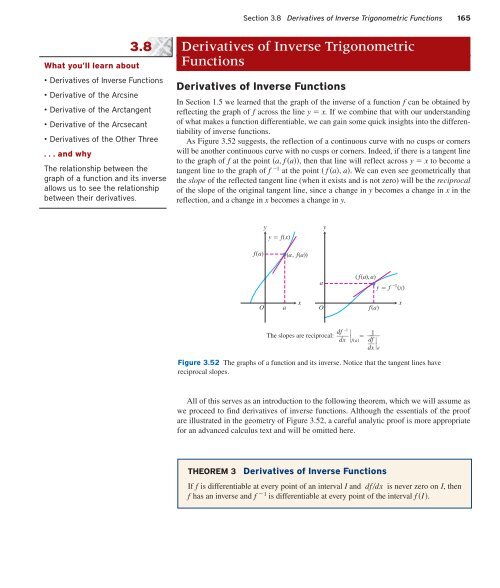5128_Ch03_pp098-184
Create successful ePaper yourself
Turn your PDF publications into a flip-book with our unique Google optimized e-Paper software.
Section 3.8 Derivatives of Inverse Trigonometric Functions 165<br />
3.8<br />
What you’ll learn about<br />
• Derivatives of Inverse Functions<br />
• Derivative of the Arcsine<br />
• Derivative of the Arctangent<br />
• Derivative of the Arcsecant<br />
• Derivatives of the Other Three<br />
. . . and why<br />
The relationship between the<br />
graph of a function and its inverse<br />
allows us to see the relationship<br />
between their derivatives.<br />
Derivatives of Inverse Trigonometric<br />
Functions<br />
Derivatives of Inverse Functions<br />
In Section 1.5 we learned that the graph of the inverse of a function f can be obtained by<br />
reflecting the graph of f across the line y x. If we combine that with our understanding<br />
of what makes a function differentiable, we can gain some quick insights into the differentiability<br />
of inverse functions.<br />
As Figure 3.52 suggests, the reflection of a continuous curve with no cusps or corners<br />
will be another continuous curve with no cusps or corners. Indeed, if there is a tangent line<br />
to the graph of f at the point a, f a, then that line will reflect across y x to become a<br />
tangent line to the graph of f 1 at the point f a, a. We can even see geometrically that<br />
the slope of the reflected tangent line (when it exists and is not zero) will be the reciprocal<br />
of the slope of the original tangent line, since a change in y becomes a change in x in the<br />
reflection, and a change in x becomes a change in y.<br />
y<br />
y f(x)<br />
y<br />
f(a)<br />
(a, f(a))<br />
a<br />
( f(a), a)<br />
y f –1 (x)<br />
O<br />
a<br />
x<br />
O<br />
f(a)<br />
x<br />
The slopes are reciprocal: ——<br />
<br />
——–<br />
1<br />
dx f(a) df<br />
—<br />
<br />
dx a<br />
Figure 3.52 The graphs of a function and its inverse. Notice that the tangent lines have<br />
reciprocal slopes.<br />
df<br />
–1<br />
All of this serves as an introduction to the following theorem, which we will assume as<br />
we proceed to find derivatives of inverse functions. Although the essentials of the proof<br />
are illustrated in the geometry of Figure 3.52, a careful analytic proof is more appropriate<br />
for an advanced calculus text and will be omitted here.<br />
THEOREM 3<br />
Derivatives of Inverse Functions<br />
If f is differentiable at every point of an interval I and dfdx is never zero on I, then<br />
f has an inverse and f 1 is differentiable at every point of the interval f I.












